Unilever Case Study: Exploring Human Resources and Motivation Theories
VerifiedAdded on 2023/06/07
|7
|1588
|106
Case Study
AI Summary
This case study provides an overview of human resource management and employee motivation, focusing on Unilever plc. It highlights the significance of the HR department in managing employees, including recruitment, training, and compliance. The study examines motivation, defining it as a process that initiates and maintains goal-oriented behavior, and explores motivational theories such as Maslow's hierarchy of needs and Herzberg's two-factor theory. It analyzes how Unilever implements various techniques to motivate employees, such as goal setting, celebrating milestones, providing feedback, empowering problem-solving, and maintaining trust. The report concludes by emphasizing the importance of a motivated work environment for achieving organizational goals.
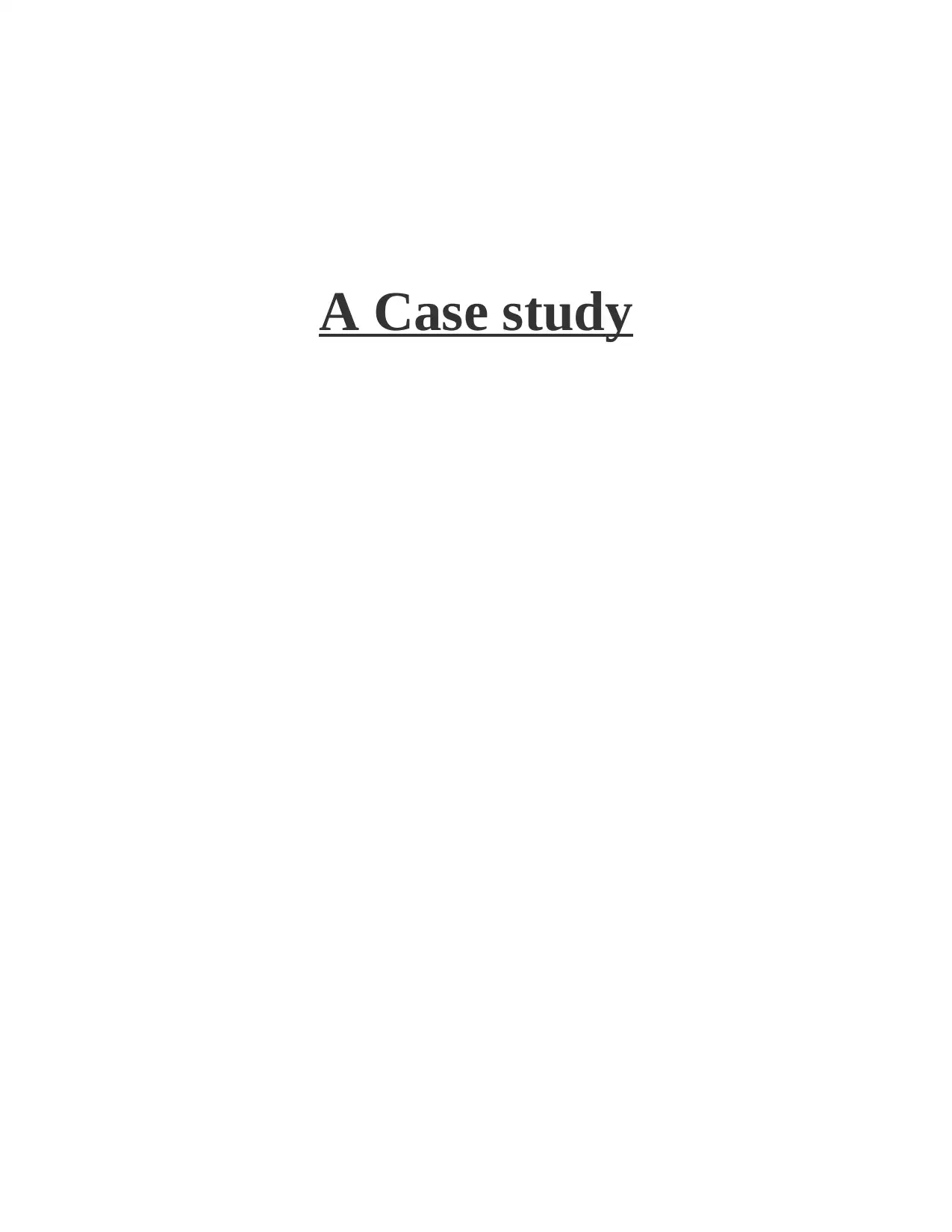
A Case study
Paraphrase This Document
Need a fresh take? Get an instant paraphrase of this document with our AI Paraphraser
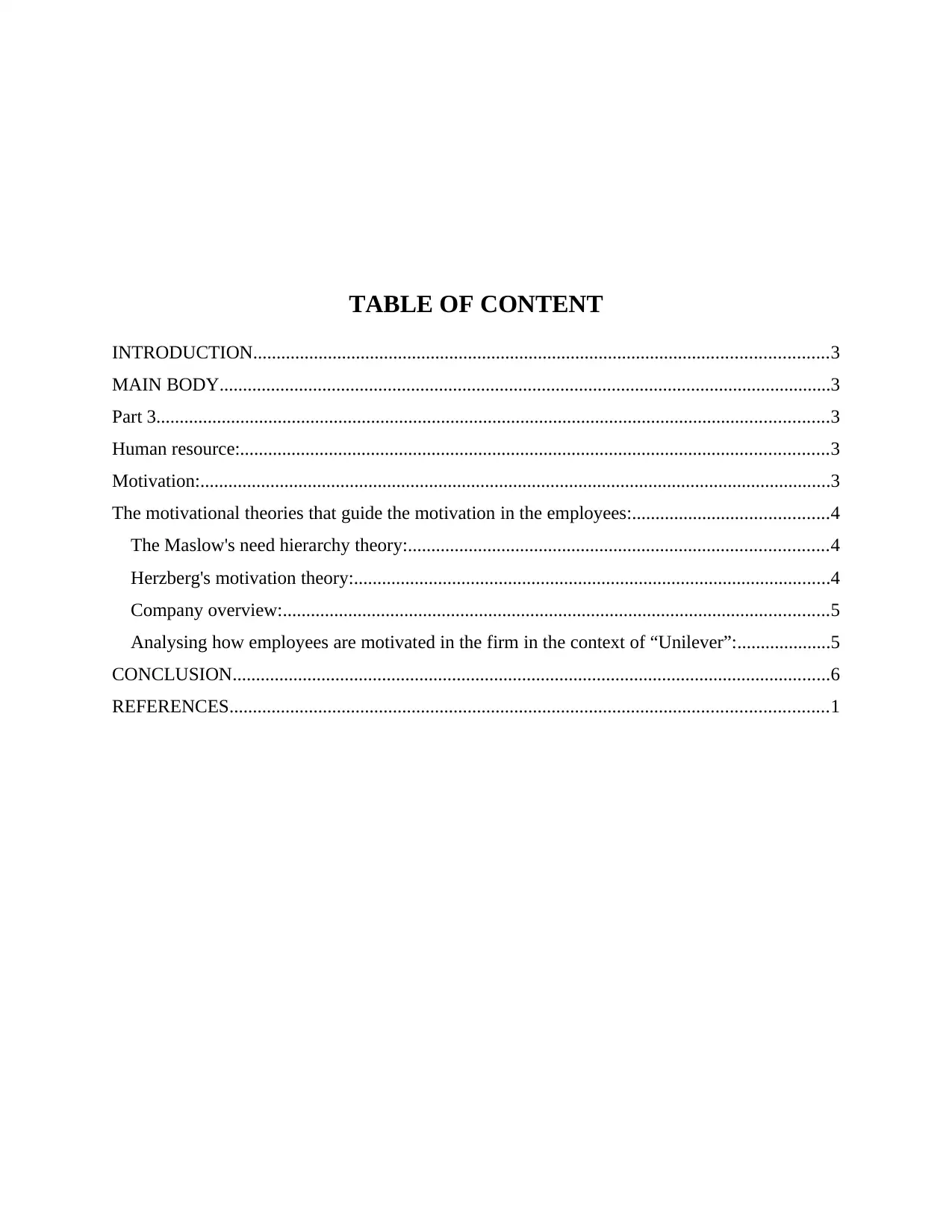
TABLE OF CONTENT
INTRODUCTION...........................................................................................................................3
MAIN BODY...................................................................................................................................3
Part 3................................................................................................................................................3
Human resource:..............................................................................................................................3
Motivation:.......................................................................................................................................3
The motivational theories that guide the motivation in the employees:..........................................4
The Maslow's need hierarchy theory:..........................................................................................4
Herzberg's motivation theory:......................................................................................................4
Company overview:.....................................................................................................................5
Analysing how employees are motivated in the firm in the context of “Unilever”:....................5
CONCLUSION................................................................................................................................6
REFERENCES................................................................................................................................1
INTRODUCTION...........................................................................................................................3
MAIN BODY...................................................................................................................................3
Part 3................................................................................................................................................3
Human resource:..............................................................................................................................3
Motivation:.......................................................................................................................................3
The motivational theories that guide the motivation in the employees:..........................................4
The Maslow's need hierarchy theory:..........................................................................................4
Herzberg's motivation theory:......................................................................................................4
Company overview:.....................................................................................................................5
Analysing how employees are motivated in the firm in the context of “Unilever”:....................5
CONCLUSION................................................................................................................................6
REFERENCES................................................................................................................................1
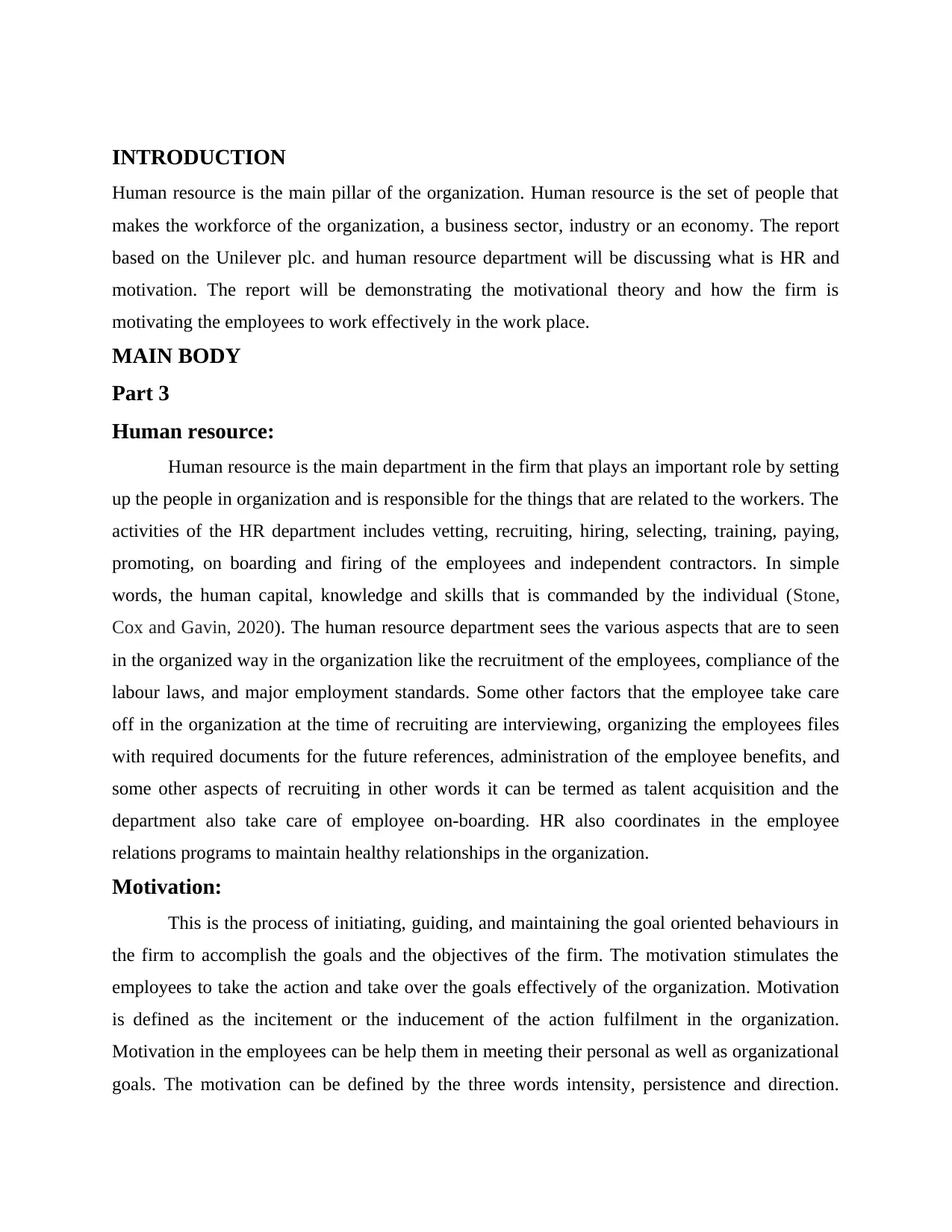
INTRODUCTION
Human resource is the main pillar of the organization. Human resource is the set of people that
makes the workforce of the organization, a business sector, industry or an economy. The report
based on the Unilever plc. and human resource department will be discussing what is HR and
motivation. The report will be demonstrating the motivational theory and how the firm is
motivating the employees to work effectively in the work place.
MAIN BODY
Part 3
Human resource:
Human resource is the main department in the firm that plays an important role by setting
up the people in organization and is responsible for the things that are related to the workers. The
activities of the HR department includes vetting, recruiting, hiring, selecting, training, paying,
promoting, on boarding and firing of the employees and independent contractors. In simple
words, the human capital, knowledge and skills that is commanded by the individual (Stone,
Cox and Gavin, 2020). The human resource department sees the various aspects that are to seen
in the organized way in the organization like the recruitment of the employees, compliance of the
labour laws, and major employment standards. Some other factors that the employee take care
off in the organization at the time of recruiting are interviewing, organizing the employees files
with required documents for the future references, administration of the employee benefits, and
some other aspects of recruiting in other words it can be termed as talent acquisition and the
department also take care of employee on-boarding. HR also coordinates in the employee
relations programs to maintain healthy relationships in the organization.
Motivation:
This is the process of initiating, guiding, and maintaining the goal oriented behaviours in
the firm to accomplish the goals and the objectives of the firm. The motivation stimulates the
employees to take the action and take over the goals effectively of the organization. Motivation
is defined as the incitement or the inducement of the action fulfilment in the organization.
Motivation in the employees can be help them in meeting their personal as well as organizational
goals. The motivation can be defined by the three words intensity, persistence and direction.
Human resource is the main pillar of the organization. Human resource is the set of people that
makes the workforce of the organization, a business sector, industry or an economy. The report
based on the Unilever plc. and human resource department will be discussing what is HR and
motivation. The report will be demonstrating the motivational theory and how the firm is
motivating the employees to work effectively in the work place.
MAIN BODY
Part 3
Human resource:
Human resource is the main department in the firm that plays an important role by setting
up the people in organization and is responsible for the things that are related to the workers. The
activities of the HR department includes vetting, recruiting, hiring, selecting, training, paying,
promoting, on boarding and firing of the employees and independent contractors. In simple
words, the human capital, knowledge and skills that is commanded by the individual (Stone,
Cox and Gavin, 2020). The human resource department sees the various aspects that are to seen
in the organized way in the organization like the recruitment of the employees, compliance of the
labour laws, and major employment standards. Some other factors that the employee take care
off in the organization at the time of recruiting are interviewing, organizing the employees files
with required documents for the future references, administration of the employee benefits, and
some other aspects of recruiting in other words it can be termed as talent acquisition and the
department also take care of employee on-boarding. HR also coordinates in the employee
relations programs to maintain healthy relationships in the organization.
Motivation:
This is the process of initiating, guiding, and maintaining the goal oriented behaviours in
the firm to accomplish the goals and the objectives of the firm. The motivation stimulates the
employees to take the action and take over the goals effectively of the organization. Motivation
is defined as the incitement or the inducement of the action fulfilment in the organization.
Motivation in the employees can be help them in meeting their personal as well as organizational
goals. The motivation can be defined by the three words intensity, persistence and direction.
⊘ This is a preview!⊘
Do you want full access?
Subscribe today to unlock all pages.

Trusted by 1+ million students worldwide
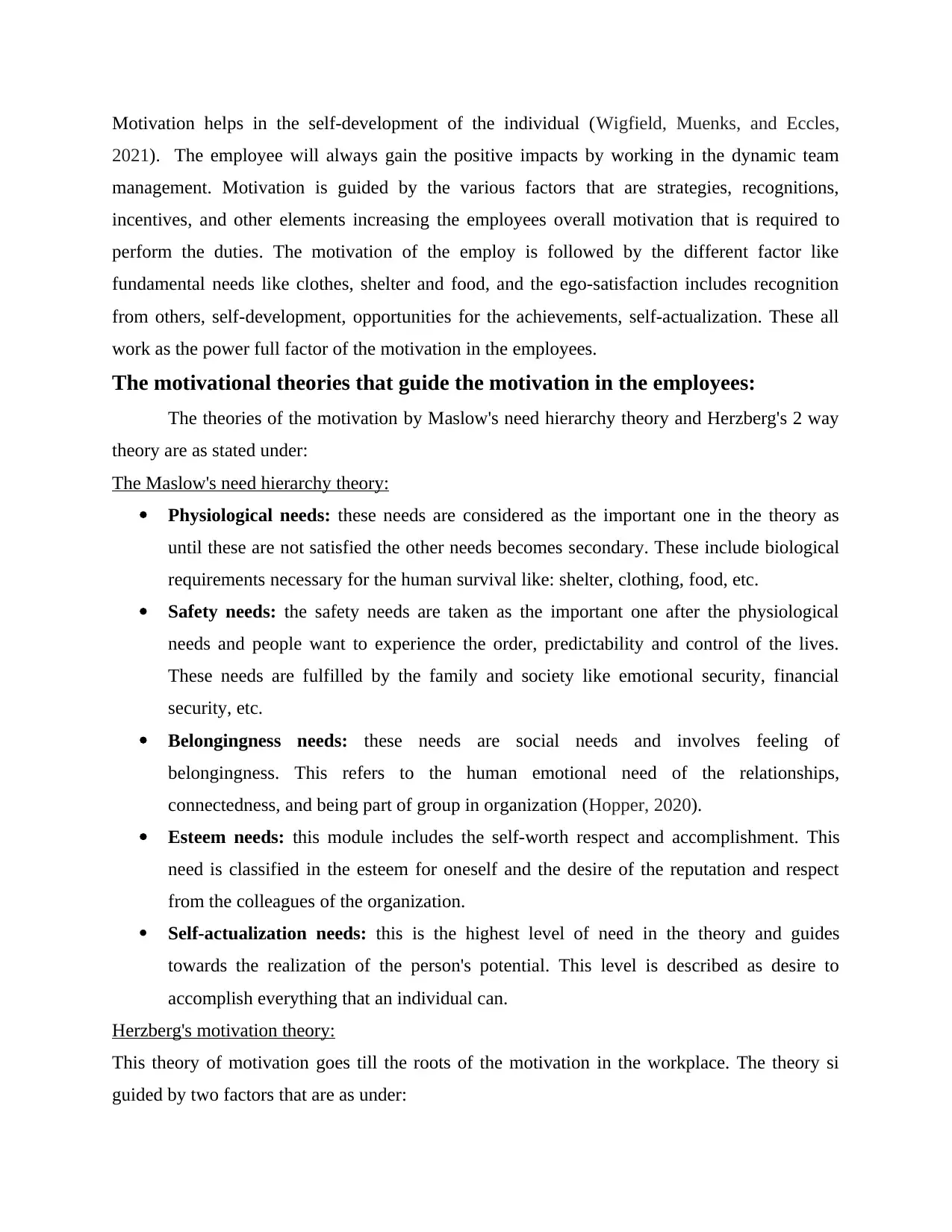
Motivation helps in the self-development of the individual (Wigfield, Muenks, and Eccles,
2021). The employee will always gain the positive impacts by working in the dynamic team
management. Motivation is guided by the various factors that are strategies, recognitions,
incentives, and other elements increasing the employees overall motivation that is required to
perform the duties. The motivation of the employ is followed by the different factor like
fundamental needs like clothes, shelter and food, and the ego-satisfaction includes recognition
from others, self-development, opportunities for the achievements, self-actualization. These all
work as the power full factor of the motivation in the employees.
The motivational theories that guide the motivation in the employees:
The theories of the motivation by Maslow's need hierarchy theory and Herzberg's 2 way
theory are as stated under:
The Maslow's need hierarchy theory:
Physiological needs: these needs are considered as the important one in the theory as
until these are not satisfied the other needs becomes secondary. These include biological
requirements necessary for the human survival like: shelter, clothing, food, etc.
Safety needs: the safety needs are taken as the important one after the physiological
needs and people want to experience the order, predictability and control of the lives.
These needs are fulfilled by the family and society like emotional security, financial
security, etc.
Belongingness needs: these needs are social needs and involves feeling of
belongingness. This refers to the human emotional need of the relationships,
connectedness, and being part of group in organization (Hopper, 2020).
Esteem needs: this module includes the self-worth respect and accomplishment. This
need is classified in the esteem for oneself and the desire of the reputation and respect
from the colleagues of the organization.
Self-actualization needs: this is the highest level of need in the theory and guides
towards the realization of the person's potential. This level is described as desire to
accomplish everything that an individual can.
Herzberg's motivation theory:
This theory of motivation goes till the roots of the motivation in the workplace. The theory si
guided by two factors that are as under:
2021). The employee will always gain the positive impacts by working in the dynamic team
management. Motivation is guided by the various factors that are strategies, recognitions,
incentives, and other elements increasing the employees overall motivation that is required to
perform the duties. The motivation of the employ is followed by the different factor like
fundamental needs like clothes, shelter and food, and the ego-satisfaction includes recognition
from others, self-development, opportunities for the achievements, self-actualization. These all
work as the power full factor of the motivation in the employees.
The motivational theories that guide the motivation in the employees:
The theories of the motivation by Maslow's need hierarchy theory and Herzberg's 2 way
theory are as stated under:
The Maslow's need hierarchy theory:
Physiological needs: these needs are considered as the important one in the theory as
until these are not satisfied the other needs becomes secondary. These include biological
requirements necessary for the human survival like: shelter, clothing, food, etc.
Safety needs: the safety needs are taken as the important one after the physiological
needs and people want to experience the order, predictability and control of the lives.
These needs are fulfilled by the family and society like emotional security, financial
security, etc.
Belongingness needs: these needs are social needs and involves feeling of
belongingness. This refers to the human emotional need of the relationships,
connectedness, and being part of group in organization (Hopper, 2020).
Esteem needs: this module includes the self-worth respect and accomplishment. This
need is classified in the esteem for oneself and the desire of the reputation and respect
from the colleagues of the organization.
Self-actualization needs: this is the highest level of need in the theory and guides
towards the realization of the person's potential. This level is described as desire to
accomplish everything that an individual can.
Herzberg's motivation theory:
This theory of motivation goes till the roots of the motivation in the workplace. The theory si
guided by two factors that are as under:
Paraphrase This Document
Need a fresh take? Get an instant paraphrase of this document with our AI Paraphraser
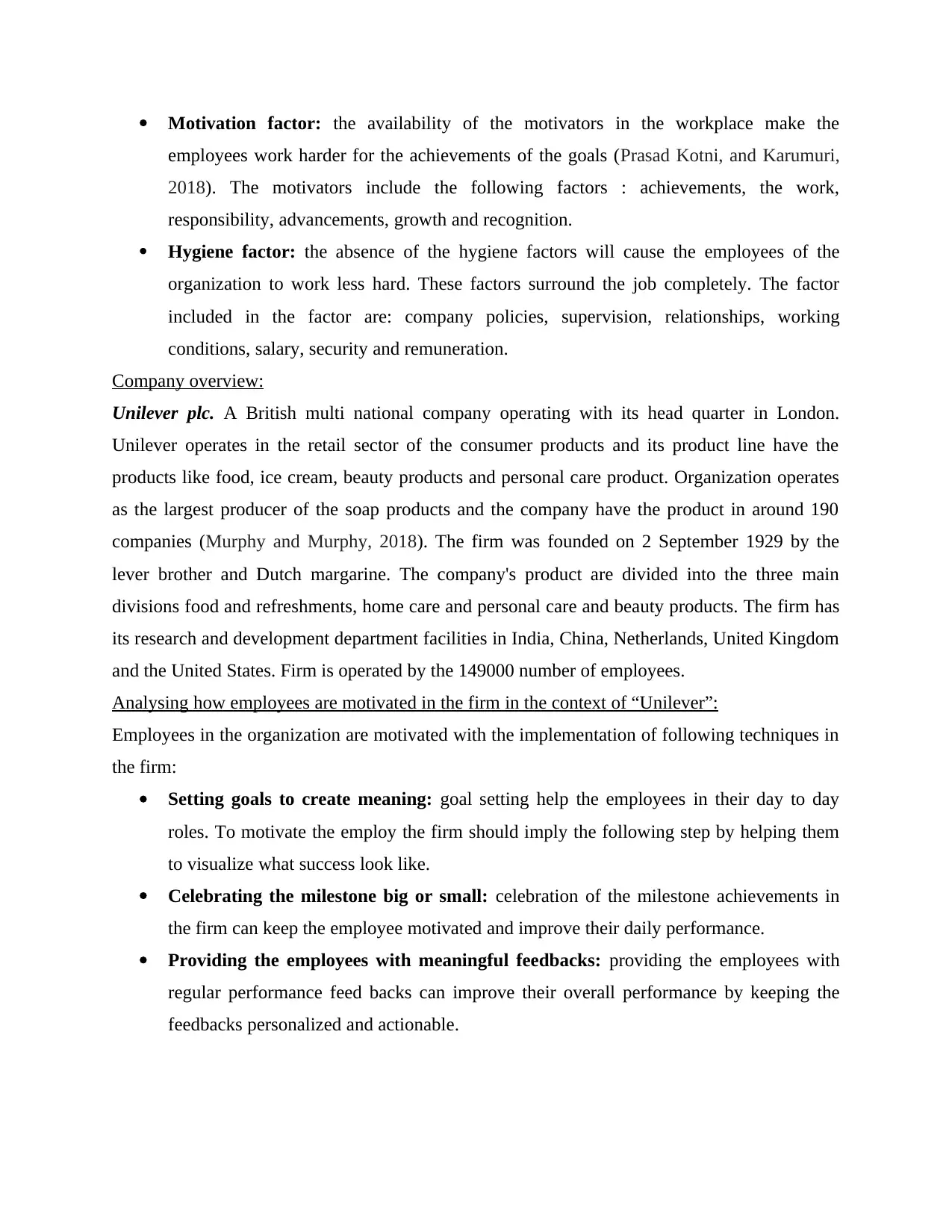
Motivation factor: the availability of the motivators in the workplace make the
employees work harder for the achievements of the goals (Prasad Kotni, and Karumuri,
2018). The motivators include the following factors : achievements, the work,
responsibility, advancements, growth and recognition.
Hygiene factor: the absence of the hygiene factors will cause the employees of the
organization to work less hard. These factors surround the job completely. The factor
included in the factor are: company policies, supervision, relationships, working
conditions, salary, security and remuneration.
Company overview:
Unilever plc. A British multi national company operating with its head quarter in London.
Unilever operates in the retail sector of the consumer products and its product line have the
products like food, ice cream, beauty products and personal care product. Organization operates
as the largest producer of the soap products and the company have the product in around 190
companies (Murphy and Murphy, 2018). The firm was founded on 2 September 1929 by the
lever brother and Dutch margarine. The company's product are divided into the three main
divisions food and refreshments, home care and personal care and beauty products. The firm has
its research and development department facilities in India, China, Netherlands, United Kingdom
and the United States. Firm is operated by the 149000 number of employees.
Analysing how employees are motivated in the firm in the context of “Unilever”:
Employees in the organization are motivated with the implementation of following techniques in
the firm:
Setting goals to create meaning: goal setting help the employees in their day to day
roles. To motivate the employ the firm should imply the following step by helping them
to visualize what success look like.
Celebrating the milestone big or small: celebration of the milestone achievements in
the firm can keep the employee motivated and improve their daily performance.
Providing the employees with meaningful feedbacks: providing the employees with
regular performance feed backs can improve their overall performance by keeping the
feedbacks personalized and actionable.
employees work harder for the achievements of the goals (Prasad Kotni, and Karumuri,
2018). The motivators include the following factors : achievements, the work,
responsibility, advancements, growth and recognition.
Hygiene factor: the absence of the hygiene factors will cause the employees of the
organization to work less hard. These factors surround the job completely. The factor
included in the factor are: company policies, supervision, relationships, working
conditions, salary, security and remuneration.
Company overview:
Unilever plc. A British multi national company operating with its head quarter in London.
Unilever operates in the retail sector of the consumer products and its product line have the
products like food, ice cream, beauty products and personal care product. Organization operates
as the largest producer of the soap products and the company have the product in around 190
companies (Murphy and Murphy, 2018). The firm was founded on 2 September 1929 by the
lever brother and Dutch margarine. The company's product are divided into the three main
divisions food and refreshments, home care and personal care and beauty products. The firm has
its research and development department facilities in India, China, Netherlands, United Kingdom
and the United States. Firm is operated by the 149000 number of employees.
Analysing how employees are motivated in the firm in the context of “Unilever”:
Employees in the organization are motivated with the implementation of following techniques in
the firm:
Setting goals to create meaning: goal setting help the employees in their day to day
roles. To motivate the employ the firm should imply the following step by helping them
to visualize what success look like.
Celebrating the milestone big or small: celebration of the milestone achievements in
the firm can keep the employee motivated and improve their daily performance.
Providing the employees with meaningful feedbacks: providing the employees with
regular performance feed backs can improve their overall performance by keeping the
feedbacks personalized and actionable.
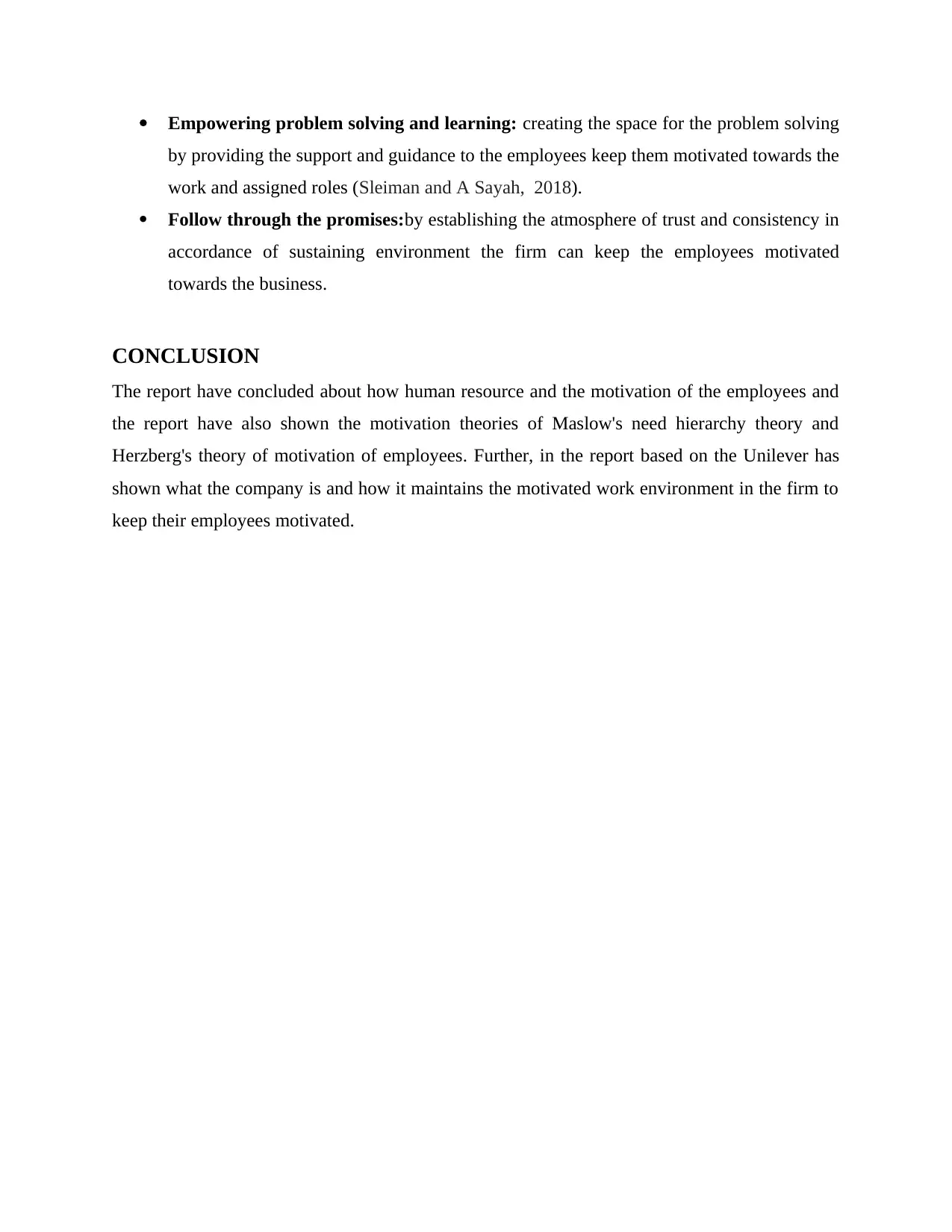
Empowering problem solving and learning: creating the space for the problem solving
by providing the support and guidance to the employees keep them motivated towards the
work and assigned roles (Sleiman and A Sayah, 2018).
Follow through the promises:by establishing the atmosphere of trust and consistency in
accordance of sustaining environment the firm can keep the employees motivated
towards the business.
CONCLUSION
The report have concluded about how human resource and the motivation of the employees and
the report have also shown the motivation theories of Maslow's need hierarchy theory and
Herzberg's theory of motivation of employees. Further, in the report based on the Unilever has
shown what the company is and how it maintains the motivated work environment in the firm to
keep their employees motivated.
by providing the support and guidance to the employees keep them motivated towards the
work and assigned roles (Sleiman and A Sayah, 2018).
Follow through the promises:by establishing the atmosphere of trust and consistency in
accordance of sustaining environment the firm can keep the employees motivated
towards the business.
CONCLUSION
The report have concluded about how human resource and the motivation of the employees and
the report have also shown the motivation theories of Maslow's need hierarchy theory and
Herzberg's theory of motivation of employees. Further, in the report based on the Unilever has
shown what the company is and how it maintains the motivated work environment in the firm to
keep their employees motivated.
⊘ This is a preview!⊘
Do you want full access?
Subscribe today to unlock all pages.

Trusted by 1+ million students worldwide
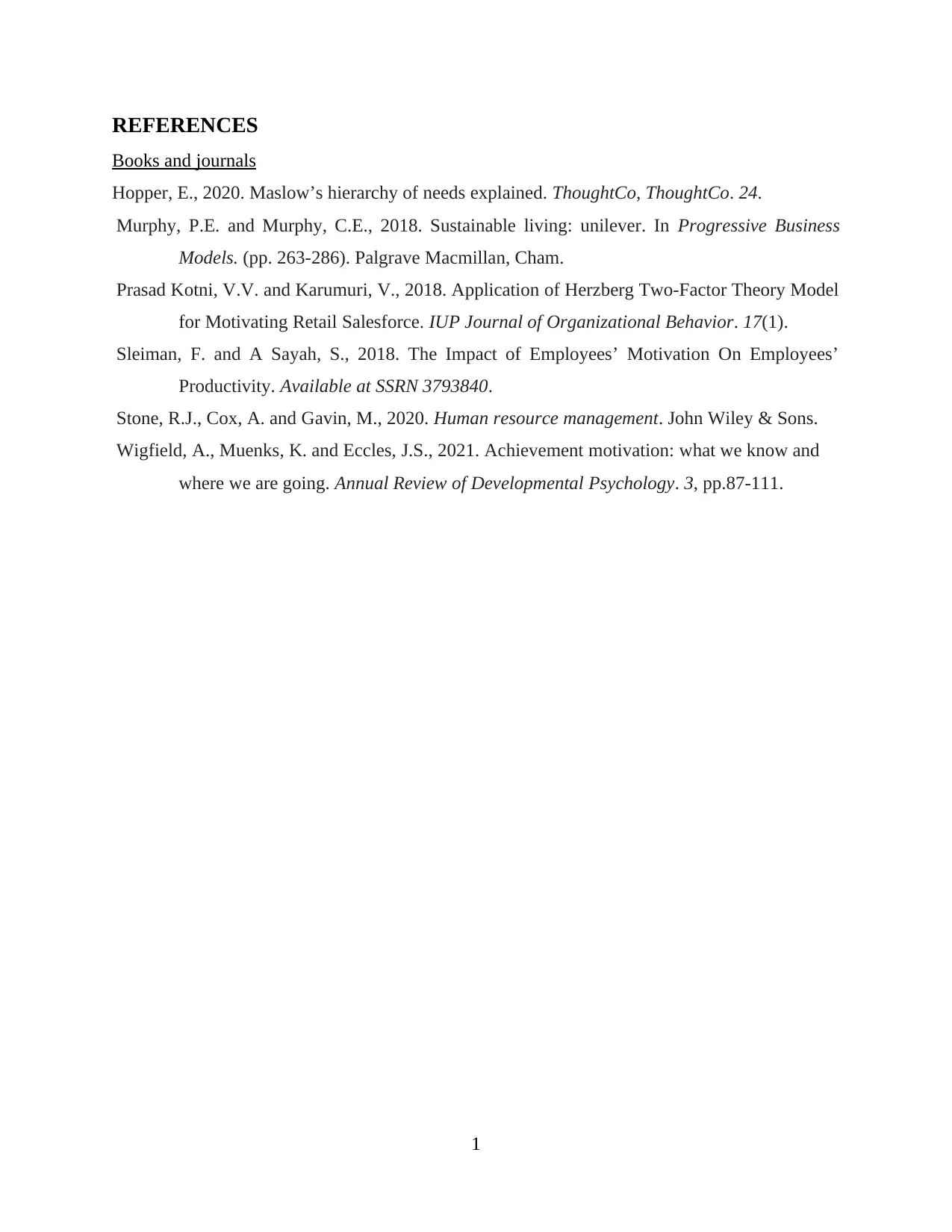
REFERENCES
Books and journals
Hopper, E., 2020. Maslow’s hierarchy of needs explained. ThoughtCo, ThoughtCo. 24.
Murphy, P.E. and Murphy, C.E., 2018. Sustainable living: unilever. In Progressive Business
Models. (pp. 263-286). Palgrave Macmillan, Cham.
Prasad Kotni, V.V. and Karumuri, V., 2018. Application of Herzberg Two-Factor Theory Model
for Motivating Retail Salesforce. IUP Journal of Organizational Behavior. 17(1).
Sleiman, F. and A Sayah, S., 2018. The Impact of Employees’ Motivation On Employees’
Productivity. Available at SSRN 3793840.
Stone, R.J., Cox, A. and Gavin, M., 2020. Human resource management. John Wiley & Sons.
Wigfield, A., Muenks, K. and Eccles, J.S., 2021. Achievement motivation: what we know and
where we are going. Annual Review of Developmental Psychology. 3, pp.87-111.
1
Books and journals
Hopper, E., 2020. Maslow’s hierarchy of needs explained. ThoughtCo, ThoughtCo. 24.
Murphy, P.E. and Murphy, C.E., 2018. Sustainable living: unilever. In Progressive Business
Models. (pp. 263-286). Palgrave Macmillan, Cham.
Prasad Kotni, V.V. and Karumuri, V., 2018. Application of Herzberg Two-Factor Theory Model
for Motivating Retail Salesforce. IUP Journal of Organizational Behavior. 17(1).
Sleiman, F. and A Sayah, S., 2018. The Impact of Employees’ Motivation On Employees’
Productivity. Available at SSRN 3793840.
Stone, R.J., Cox, A. and Gavin, M., 2020. Human resource management. John Wiley & Sons.
Wigfield, A., Muenks, K. and Eccles, J.S., 2021. Achievement motivation: what we know and
where we are going. Annual Review of Developmental Psychology. 3, pp.87-111.
1
1 out of 7
Related Documents
Your All-in-One AI-Powered Toolkit for Academic Success.
+13062052269
info@desklib.com
Available 24*7 on WhatsApp / Email
![[object Object]](/_next/static/media/star-bottom.7253800d.svg)
Unlock your academic potential
Copyright © 2020–2025 A2Z Services. All Rights Reserved. Developed and managed by ZUCOL.




